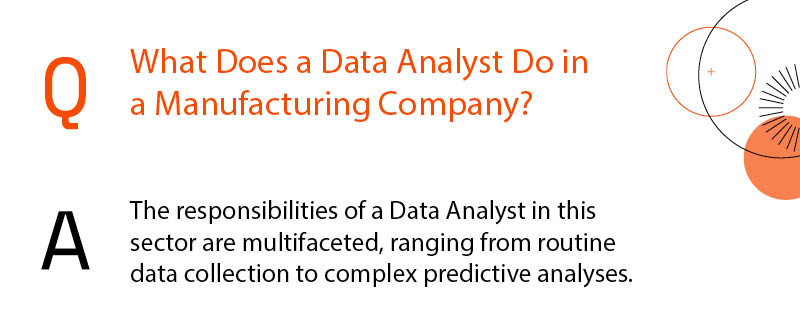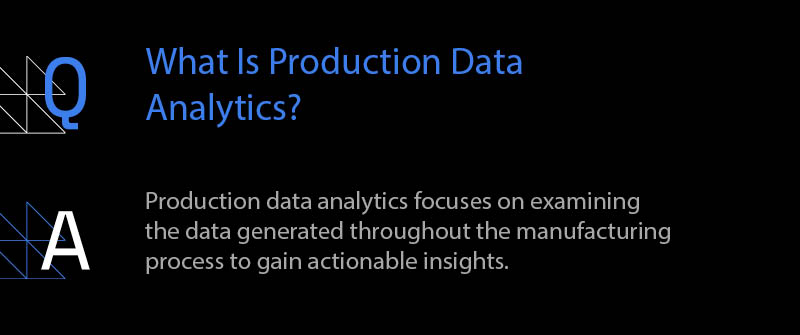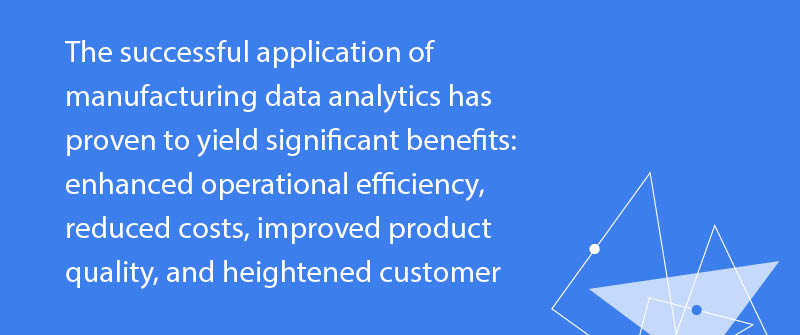
What Is Manufacturing Data Analytics?
Analytics in manufacturing involves collecting, processing, and analyzing data from various manufacturing sources to make informed decisions that drive efficiency, improve quality, and reduce costs. This can include data from machinery, production lines, supply chains, and even customer feedback.

What Is The Importance of Data Analytics in Manufacturing?
Data analytics is crucial in the manufacturing sector for several reasons. First and foremost, it enables better decision-making. By analyzing data, manufacturers can optimize processes, predict maintenance needs, and improve product quality. This not only minimizes downtime and reduces operational costs but also enhances overall productivity.
Historical Perspective of Manufacturing Data Analytics
The concept of using data to drive manufacturing processes isn’t new. Historically, manufacturers relied on basic statistics and manual data collection to make decisions. However, advances in technology have made it possible to collect and analyze vast amounts of data in real time. This evolution has allowed the industry to transition from reactive to proactive to predictive analytics, ensuring that businesses are always one step ahead.
Understanding the basics of manufacturing data analytics is essential for any modern manufacturer looking to stay competitive. Not only does it provide a pathway to more efficient operations, but it also fosters innovation and continuous improvement, setting the stage for long-term success
What Are The Core Components and Concepts for Manufacturing Analytics?
Manufacturing data analytics hinges on several core components and concepts:
- Data Collection: Gathering raw data from diverse sources like sensors, machines, and enterprise software systems.
- Data Storage: Securely storing the collected data, often in data lakes or cloud-based solutions, to ensure data integrity and accessibility.
- Data Processing: Cleaning and transforming data to prepare it for analysis.
- Data Analysis: Employing statistical models, machine learning algorithms, and other analytical tools to extract patterns and insights.
- Data Visualization: Utilizing dashboards, charts, and graphs to present data findings in an easily understandable format for stakeholders.
What Are the Use Cases Of Manufacturing Analytics?
Real-world use cases of manufacturing data analytics are abundant.
For instance, in automotive manufacturing, data analytics can monitor the assembly line in real time to identify and rectify inefficiencies promptly. In the pharmaceutical industry, it can ensure compliance with stringent regulatory standards by maintaining meticulous records of production data.
Another compelling example is predictive maintenance. By continuously analyzing machine data, manufacturers can foresee potential failures before they occur, thereby avoiding costly downtime and extending the lifespan of critical equipment.
Overall, whether it’s for streamlining supply chains, enhancing product design, or driving customer satisfaction, the potential applications of manufacturing data analytics are both vast and transformative. Embracing these technologies isn’t just an option but a necessity for businesses aspiring to lead in today’s fiercely competitive landscape.
What Does a Data Analyst Do in a Manufacturing Company?
In a manufacturing company, a Data Analyst plays a pivotal role in optimizing the production process by leveraging data to drive decision-making. The responsibilities of a Data Analyst in this sector are multifaceted, ranging from routine data collection to complex predictive analyses. To give you a comprehensive understanding, let’s delve into their key responsibilities, daily tasks, their role in decision-making, and the required skills.

Key Responsibilities of a Data Analyst
The primary duty of a Data Analyst in manufacturing is to collect, process, and analyze data to identify trends and patterns. These professionals work with large datasets from various sources like sensors on machinery, quality control systems, and supply chain logs. By transforming raw data into actionable insights, they help streamline operations, reduce costs, and improve quality control. Additionally, they often create dashboards and visualizations to communicate these findings effectively to decision-makers within the organization.
Daily Tasks of a Data Analyst
The daily activities of a Data Analyst in manufacturing are rigorous and diverse. They often start their day by running routine data integrity checks to ensure the accuracy and reliability of the data collected. This is followed by data cleansing and preprocessing to prepare it for analysis. Throughout the day, they engage in various forms of data examination, including statistical analysis, predictive modeling, and trend analysis. They also collaborate closely with other departments, such as production, quality assurance, and supply chain, to understand their data needs and provide tailored analytical solutions.
Role in Decision-Making Processes
A Data Analyst in a manufacturing company doesn’t just crunch numbers; they are also integral to the decision-making process. Their insights can influence a wide range of strategic decisions, from improving production line efficiency to optimizing the supply chain. They provide the data-backed evidence that managers and executives need to make informed decisions, thereby minimizing risks and maximizing productivity.

Required Skillsets for a Data Analyst
To excel as a Data Analyst in the manufacturing industry, a diverse set of skills is necessary. Proficiency in programming languages like Python and R and expertise in database management systems like SQL modeling are essential. A solid understanding of statistical analysis and machine learning algorithms is crucial for performing predictive analytics. Additionally, soft skills such as effective communication and teamwork are vital, as these professionals must regularly present complex data in a comprehensible manner to non-technical stakeholders.
In summary, the role of a Data Analyst in a manufacturing company is indispensable. They are the bridge between data and decision-making, ensuring that the organization leverages its data assets to maintain a competitive edge.
What Is Analytical Manufacturing?
Analytical manufacturing is more than just a buzzword; it’s a transformative approach that integrates data analysis into every phase of manufacturing. This involves the systematic use of data and statistical tools to evaluate and enhance manufacturing processes. The goal is to achieve higher efficiency, reduce waste, and improve product quality.
Definition and Scope
At its core, analytical manufacturing refers to the application of advanced analytics to streamline and optimize manufacturing operations. This includes everything from supply chain management to real-time monitoring on the production floor. The scope covers predictive analytics, where historical data is utilized to forecast future trends, and prescriptive analytics, which suggests actionable steps to achieve desired outcomes.
Benefits of Analytical Manufacturing
The benefits of adopting analytical manufacturing are substantial. Businesses can enjoy increased operational efficiency by identifying and eliminating bottlenecks. Improved product quality is another significant advantage, as data analytics enables factories to detect and correct defects in real time. Additionally, cost reduction is achieved by minimizing waste and optimizing resource allocation.
Technological Tools Used for Analytical Manufacturing
Several technological tools are employed to harness the power of analytical manufacturing. IoT (Internet of Things) devices collect real-time data from machinery, while Machine Learning algorithms analyze this data to uncover patterns and predict maintenance needs. Advanced software like ERP (Enterprise Resource Planning) systems integrate various functional areas of a business, providing a unified platform for data analysis. Visualization tools like Power BI and Tableau help present complex data in an easily understandable format, aiding in better decision-making.
Examples of Successful Implementation
Real-world examples demonstrate how companies have successfully adopted analytical manufacturing. For instance, a leading automotive manufacturer implemented predictive analytics in its assembly line, reducing downtime by 30%. Similarly, a consumer electronics firm used machine learning to optimize its supply chain, resulting in a 20% reduction in logistics costs. These examples underscore the transformative potential of integrating data-driven decisions into manufacturing.
In conclusion, analytical manufacturing is a key driver for innovation and efficiency in today’s competitive business environment. By leveraging data and advanced analytics, manufacturers can make informed decisions that lead to measurable improvements in performance, cost-efficiency, and product quality.
What Is Production Data Analytics?
Production data analytics focuses on examining the vast amounts of data generated throughout the manufacturing process to gain actionable insights, unlike general manufacturing data analytics, which encompasses a broader view of the whole manufacturing lifecycle, production data analytics zeroes in on specific production phases, from raw materials to final product assembly.
One of the main differences between production data analytics and generic manufacturing data analytics lies in their application. While manufacturing data analytics looks at the overall manufacturing workflow, supply chain logistics, and market trends, production data analytics drills down on the efficiency, quality control, and real-time monitoring of the production line. This specific focus enables companies to optimize their production processes, reduce waste, and improve product quality.

Applications in the Production Process
In the realm of the production process, data analytics is utilized in multiple facets:
Predictive Maintenance
Predictive maintenance leverages production data analytics to forecast potential equipment failures before they occur. By analyzing historical data and identifying patterns, companies can schedule maintenance more effectively, thus minimizing downtime and extending machine life.
Quality Control
Quality control is another critical area where production data analytics consulting plays a significant role. By continuously monitoring production data, businesses can detect deviations from quality standards in real-time, allowing for immediate corrections and ensuring consistently high product quality.
Process Optimization
Production data analytics helps in optimizing various processes, such as workflow management, resource allocation, and production scheduling. By examining the data, companies can identify bottlenecks and areas of inefficiency, leading to a more streamlined and cost-effective production system.
Manufacturing Analytics Examples and Case Studies
Case Study 1: Scrubbing Data to Drive Efficiency at Bar Keepers Friend
Bar Keepers Friend, a leading manufacturer of cleaning products, partnered with P3 Adaptive to implement advanced data analytics solutions. By integrating real-time dashboards and optimizing inventory management, Bar Keepers Friend was able to streamline operations, reduce manual data tasks by 20%, and enhance decision-making. The improved data visibility led to over $1M in cash flow improvements and more efficient production processes. This data-driven approach allowed Bar Keepers Friend to maintain their competitive edge while setting new standards for efficiency and innovation in manufacturing.
Case Study 2: Streamlining Operations at Kuraray Chemical Plant
Kuraray implemented Power BI to monitor and analyze performance data across their global chemical manufacturing operations. By integrating data from various production systems, they could identify inefficiencies in real-time and adjust processes proactively. This approach significantly enhanced their operational efficiency, reducing process downtime by 30% and increasing productivity across their plants.
Lessons Learned
These examples highlight several crucial lessons:
- Data Integration: Effective synthesis of data from multiple sources is vital for thorough analysis and obtaining actionable insights.
- Real-Time Analytics: Implementing real-time analytics is key for making informed decisions quickly and adapting to operational changes efficiently.
- Custom Solutions: Developing analytics solutions tailored to address specific challenges can lead to substantial operational improvements.
Examples of Manufacturing Data Analytics Tools
Overview of Popular Tools Manufacturing data analytics relies on a variety of robust tools to process, analyze, and visualize data. These tools not only help capture real-time data but also aid in predictive analytics and increase manufacturing process improvements. Some of the leading manufacturing data analytics tools include Microsoft Power BI, Tableau, SAS, and Hadoop. Each of these tools offers unique capabilities that serve different facets of manufacturing analytics.

Microsoft Power BI Microsoft Power BI stands out for its robust integration with other Microsoft products, making it particularly useful for companies already embedded in the Microsoft ecosystem. Power BI offers comprehensive data visualization and reporting features, enabling manufacturing teams to gain real-time insights and make manufacturing data-driven decisions immediately. While the platform can be challenging for beginners, its integration benefits and scalability often outweigh the initial learning curve.
Tableau As a leading data visualization tool, Tableau allows users to create interactive and shareable dashboards. Its functionality makes it easier to uncover insights and trends hidden within complex manufacturing datasets. With features like drag-and-drop simplicity, it is especially well-suited for teams with diverse skill sets. However, the cost of Tableau can be prohibitive for smaller enterprises, and its advanced features may require specialized training.
SAS SAS is a powerful tool for predictive analytics and advanced data analysis. It provides manufacturing companies with the ability to manage large volumes of data, perform intricate statistical analysis, and apply sophisticated predictive models. This makes SAS an ideal choice for companies looking to leverage complex analytics for predictive maintenance and process optimization. However, SAS can be expensive and complex, which may deter smaller organizations without dedicated analytical teams.
Hadoop Hadoop is an open-source framework that helps in storing and processing large data sets across distributed computing environments. It’s particularly effective for dealing with massive data volumes generated in manufacturing processes. Hadoop’s flexibility and scalability make it invaluable for big data analytics, although setting up and maintaining a Hadoop environment requires significant technical expertise, which can be a barrier for smaller operations.
Comparative Analysis
Choosing the right tool often depends on the specific requirements and existing technological landscape of a manufacturing company. For example, Tableau excels in visualization, making it a perfect fit for teams that need to present data insights compellingly. On the other hand, SAS is geared more towards advanced analytics and predictive modeling, which is suitable for companies with complex data needs.

Usage Scenarios
Different manufacturing environments have various requirements, and thus, the choice of tools can vary. For instance, a company focused on predictive maintenance might favor SAS due to its strong predictive analytics capabilities. Conversely, a manufacturing unit that needs to integrate data across multiple existing Microsoft products might find Power BI beneficial. Similarly, industries dealing with massive datasets regularly, like automotive manufacturing, would benefit from Hadoop’s large-scale data processing capabilities.
Impact on Business Efficiency
The successful application of manufacturing data analytics has proven to yield significant benefits: enhanced operational efficiency, reduced costs, improved product quality, and heightened customer satisfaction. These advantages not only fortify a company’s competitive edge but also lay the groundwork for sustained growth and long-term success in the manufacturing sector.

Future Perspectives
With the manufacturing sector increasingly embracing digital transformation, the role of data analytics will only grow. Companies that invest in the right tools and talent will find themselves better equipped to innovate and stay ahead of the competition. Emerging technologies such as AI, machine learning, and IoT will further enhance the capabilities and applications of data analytics in manufacturing.
Final Thoughts
The journey through manufacturing data analytics underscores a universal truth: data, when harnessed correctly, becomes a powerful ally in achieving efficiency, innovation, and competitive advantage. For business leaders, the imperative is clear—to stay ahead, one must not just adapt but lead the charge in data-driven decision-making.
Master the complexities of data with P3 Adaptive. Our seasoned consultants integrate your scattered data into a unified, insightful view, transforming bewildering details into impactful, actionable strategies. Empower your business to make swift and confident decisions, propelling your organization forward with clarity and precision. Speak to a consultant today!
Get in touch with a P3 team member